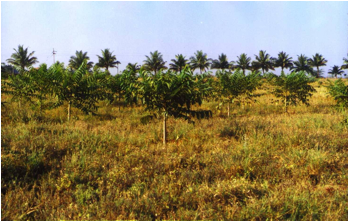
Increase the agricultural production, income and recycling of farm residues, integrating a variety of agricultural and agro-based industries conducting is called as integrated farming system.
Integrated farming system follow agro forestry settings, cereals production and goat rearing, backyard chicken farming, vermiculture manure, fodder and fruit trees intercropping system, bio bunds, live fencing, Jasmine grazing land, raising corn, combined with stylo production and Neem with the sheep husbandry with the annual cropping make considerable amount of profit.
In Tamil Nadu, 11.18 million dairy cows, 2 million buffalo races and 17.26 million sheep are reared. However, because the state lacks the fodder needed for the livestock herds is unable to express their full productive potential. The Government of Tamil Nadu and farmers engaged in the production of fodder for different kinds of projects is implemented. Livestock farming farmers not giving importance to fodder cultivation. In this case, the samples of agro forestry conjunction with agriculture, cropping and green fodders and livestock integration is the best way. There is a need for better land for the cultivation of fodder. Depending on the number of livestock, farmers in the farm, fodders as individual crop or other agri crops or fruit trees can be grown in between the available space. Such that in specifying land apart not only doing agriculture crops and cultivating green fodders with cattles get maximum income. By continuing the cultivation of a particular area throughout the year, fixed income and can be obtained from the meadow.
Agro forestry, tree intercropping, live furrow, live fencing in between orchard, green fodder production, jasminum pasture might be adopted in integrated farming system.
Tree intercropping method:

Fodder tree species were planted in specified interval and in between the spaces Agriculture crops can be grown this method is called as tree intercropping system.
In this land tree fodders can be planted in10 m gap viz., Supapul and glyciridia such trees will be planted. In this method we can get green leaves able to feed 15 to 18 sheeps will be grown up. In this method, 10 to 11 tonnes of green fodders will be produced.
Setting bio bunds:
In general, to prevent soil erosion, protecting moisture the bunds of 1 to 2 feet height to be made and grow grasses like kolukkattaipul, guinea grass were planted and the bunds on both sides in 10 m gap as supapul or Gliricidia seedlings will be planted. These plants provided with a well-developed, and they should be cut at a height of 6 feet from the ground. The new branches will grow much and get high tree leaves. From approximately 100 m length furrow one year to the life of the greens can produce from 500 to 1000 kg.
Bio-fencing: Surrounding lands instead of setting up of iron fencing fodder trees can be planted as bio fence. Surrounding the land larger growing trees like udhiyan, thespesia, kodukkapuli such wood species could be planted in 4 to 5 m intervals. The small gap between these trees small trees like Supabul, Gliricidia can be grown. These trees should be pruned at 1.5 m height to generate new lateral branches can be used as feed for animals. From the bio fence we can get 3 or 4 tonnes of fodder could be available to livestock annually.
Fodder production in coconut garden: Coconut trees are usually planted at a spacing of 8 m. In general, in between coconut trees the land is being not used properly and left as fallow land. Because of this soil fertility is reduced day by day. Whatever the lateral extent of the coconut tree leaves goes similarly the length of the root also extended. Therefore, the gap between the two trees, small trees such as supapul, legume fodder varieties such as kalappakkoniyam and stylo can be cultivated to increase the fodder production. Bottom of the coconut tree planting stylo will help to fix the nitrogen and increase the coconut productivity and also supply protein rich fodder to the livestock. In this method, from an acre of coconut garden we can get about 15 tonnes fodder.
Fodder production between orchard trees:
Fruit trees are often planted in the spacing of 10 m X10 m or 12 m X12 m and the orchards were developed. Generally, roots of fruit trees spread horizontally, laterally and deeply based on water requirement.
During heavy rainfall season, the rain drops caused soil erosion in the inter spacing area of fruit trees. In the fallow soil if planted with plants or forages will serve as a cover crop and protect soil erosion. In between fruit trees soil surfaces can be utilized for raising cattle fodders.
Mullai pasture land development:
In irrigated lands, when cumbu-napier grass is grown, shrubs like supapul, Gliricidia, Mulberry, Agathi planted in 2 x 2 m2 spacing as intercrop and its leaves harvested and given as fodder.
Sorghum + Stylo:
After sorghum and pearl millet cultivation the particular land kept as fallow due to this soil erosion occurs. In this kind of land cultivation is done once a year. Instead of this after sowing above crops, sow the stylo seeds @ 5 ½ kg per acre. Sorghum and cumbu were fast growing nature and whereas stylo is in slow growth. After harvest of grain crops like sorghum and cumbu, the stylo receives direct sunlight and show profound growth. If this crop harvested after attained full maturity the seeds will fall on the same land and it will germinate in the next year monsoon season. Once the stylo sown, it will give forages for next 2-3 years even without grain crops cultivation. And also stylo fix the atmospheric nitrogen in the soil will have chance to increase the yield of sorghum.
Therefore, those who are all involved in agriculture and livestock farming practices facing input availability and labor scarcity problems can be solved and also increased productivity and additional income will be obtained through agroforestry and integrated farming system is a better approach to get sustained income.
|


